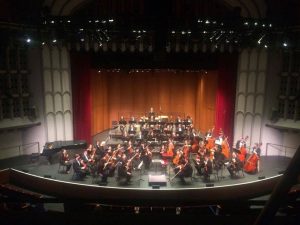Orchestra explores works of Beethoven in concert
The USC Thornton Chamber Orchestra performed an all-Ludwig van Beethoven program Friday night in Bovard Auditorium. The concert consisted of select symphonic works including “Trio for 2 Oboes & English horn,” “Op. 87, Finale: Presto,” “Coriolan Overture,” “Symphony No. 5, Op. 67” and “Overture from Egmont,” three songs for voice and piano trio and three works for trombone choir “3 Equali for Four Trombones.” Principal conductor Carl St. Clair led the evening’s performance.
Opening the concert, oboists Laura Arganbright, Bhavani Kotha and English horn Marissa Honda performed Beethoven’s “Trio for 2 Oboes & English Horn in C Major.” Hours of practice and rehearsal culminated in a detailed and well-executed performance. The trio composition echoed the styling of many pieces performed. While all by Beethoven, the pieces had compositional characteristics that would suggest otherwise to a casual listener.

Chad Lonski | Daily Trojan
A Night of Beethoven · The Thornton Chamber Orchestra performed some of Beethoven’s standard and lesser-known works Friday night in Bovard Auditorium. Conductor Carl St. Clair called it an “expedition.”
“How many of you would say that was Beethoven? I guarantee you not many hands should go up right now … [This trio] was written when he was a mere 21 years old — he was under the influence of Mozart. The first movement of this trio, definitely Mozart, the adagio, definitely Beethoven, the last movement much more influenced by Joseph Haydn,” St. Clair said. “This [concert] was my way of welcoming you to a Beethoven expedition where we are going to have a chance to look at various aspects of Beethoven’s life.”
Digging further into the lesser-known corners of Beethoven’s composing career, a trio with Somang Jaegal on piano, Hanbyul Jang on violin and Benjamin Lash on cello performed alongside vocalists in three of Beethoven’s lesser-known songs. Matt Hough performed “The Pulse of an Irishman,” Irena Preda played “His Boat Comes on the Sunny Tide,” Zhengyi Bai took on “Put Round the Bright Wine,” and collectively they performed “Come Fill, Fill, My Good Fellow.” Beethoven, not widely known for vocal works, was justly represented by the vocalists.
The orchestra put on Beethoven’s well-known “Egmont Overture” with great musicianship. The musicians were able to blend and balance instruments as well as phrases in the piece, handling every challenging passage thrown at them. The same level of skill was noticeable in the performance of Beethoven’s 5th Symphony. The orchestra performed with intricate handling of the piece’s intonation. St. Clair’s leadership of the orchestra was equally as commendable, his excitement and embodiment for the piece was apparent on the podium, his feet never planted closer than a foot apart, transforming into a dynamic reflection of the orchestra.
Performed by nine trombones, and led by professor of trombone chair Terry Cravens, “3 Equali for Four Trombones” was perhaps the least expected piece of the evening. An equali is a short choral type composition usually written for religious processions and funeral services. The three in the concert were composed by Beethoven in 1812, St. Clair explained.
“Two of the three Equali were performed at the funeral procession of Ludwig von Beethoven. When you hear the sound of trombones, in the theological way of thinking, you are hearing a divine being,” St. Clair said.
The trombonists were able to perform the delicate piece with great care balancing the power of the instrument with the delicacy of the piece, meeting all of the chords and lyrical progressions with great accuracy.
Unlike “Overture from Egmont” and “Symphony No. 5,” which have been staples in concert programs for centuries, it was an eye-opening experience to explore the deeper lesser-known history of Beethoven’s composition anthology. St. Clair’s dedication not only as a conductor and musician, but also as an educator, is apparent in his explanation of the pieces making the concert as much of a cultural survey as it was an orchestral performance.
